|
|
|
Sort Order |
|
|
|
Items / Page
|
|
|
|
|
|
|
| Srl | Item |
| 1 |
ID:
094395


|
|
|
|
|
| Publication |
2010.
|
| Summary/Abstract |
The purpose of this paper is to analyse how oil export dependencies of Middle East and North African (MENA) oil producers have evolved over the past two decades and to identify the main driving factors from an energy policy perspective. The paper expresses the oil export dependency of each economy in terms of a multiplicative identity that captures effective export price, export to primary oil supply ratio, oil dependency and oil export intensity of the country. Using the data for 1980-2006, the evolution in these factors is investigated for seven MENA countries and the influence of the above factors is decomposed using the Laspeyres index. The analysis shows that energy price and increasing energy intensity in the MENA countries have influenced the overall oil export dependency. Reducing the energy intensity can improve oil export revenue share to GDP by 5-10% in most of the countries while Iran can gain significantly by increasing its export volume.
|
|
|
|
|
|
|
|
|
|
|
|
|
|
|
|
| 2 |
ID:
115695
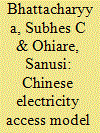

|
|
|
|
|
| Publication |
2012.
|
| Summary/Abstract |
The economic and infrastructural disparities between the rural and urban communities of most developing countries in general and in terms of energy access in particular are quite glaring. China presents a good example of a developing country that has successfully embarked on rural electrification projects over the last few decades and achieved a great feat of almost 100% electrification rate (IEA, 2009. World Energy Outlook, 2009, International Energy Agency, Paris (see IEA website at http://www.worldenergyoutlook.org/electricity.asp.)). The purpose of this paper is to find out how China has achieved this feat; how China's rural energy projects were financed and whether China provides lessons for other countries to follow.
The above questions are examined through an extensive literature review and the paper finds that unlike many other countries following the top-down approach to rural electrification, China has preferred to use a phased development through a bottom-up approach where local resources, and village level development and empowerment played an important role. While the state provided the overall guidance and financial support, the integrated rural development approach has produced local-level solutions that are subsequently integrated to produce an alternative development pathway. Strong government commitment, active local participation, technological flexibility and diversity, strong emphasis on rural development through agricultural and industrial activities and an emphasis on capacity building and training have also played an important role in the success. However, despite achieving the universal access objective, China still faces a number of issues related to rural electricity use, especially in terms of regional use patterns, long-term sustainability of supply and commercial operation of the systems. The Chinese model could serve as an inspiration for other developing countries trying to ensure universal electricity access.
|
|
|
|
|
|
|
|
|
|
|
|
|
|
|
|
| 3 |
ID:
108764
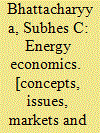

|
|
|
|
|
| Publication |
Verlag, Springer, 2011.
|
| Description |
xxvi, 721p.
|
| Standard Number |
9780857292674, hbk
|
|
|
|
|
|
|
|
|
|
|
|
Copies: C:1/I:0,R:0,Q:0
Circulation
| Accession# | Call# | Current Location | Status | Policy | Location |
| 056395 | 333.7/BHA 056395 | Main | On Shelf | General | |
|
|
|
|
| 4 |
ID:
150658
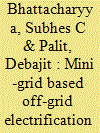

|
|
|
|
|
| Summary/Abstract |
With 1.2 billion people still lacking electricity access by 2013, electricity access remains a major global challenge. Although mini-grid based electrification has received attention in recent times, their full exploitation requires policy support covering a range of areas. Distilling the experience from a five year research project, OASYS South Asia, this paper presents the summary of research findings and shares the experience from four demonstration activities. It suggests that cost-effective universal electricity service remains a challenge and reaching the universal electrification target by 2030 will remain a challenge for the less developed countries. The financial, organisational and governance weaknesses hinder successful implementation of projects in many countries. The paper then provides 10 policy recommendations to promote mini-grids as a complementary route to grid extension to promote electricity access for successful outcomes.
|
|
|
|
|
|
|
|
|
|
|
|
|
|
|
|
| 5 |
ID:
094898
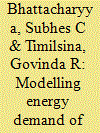

|
|
|
|
|
| Publication |
2010.
|
| Summary/Abstract |
This paper critically reviews existing energy demand forecasting methodologies highlighting the methodological diversities and developments over the past four decades in order to investigate whether the existing energy demand models are appropriate for capturing the specific features of developing countries. The study finds that two types of approaches, econometric and end-use accounting, are commonly used in the existing energy demand models. Although energy demand models have greatly evolved since the early seventies, key issues such as the poor-rich and urban-rural divides, traditional energy resources and differentiation between commercial and non-commercial energy commodities are often poorly reflected in these models. While the end-use energy accounting models with detailed sectoral representations produce more realistic projections as compared to the econometric models, they still suffer from huge data deficiencies especially in developing countries. Development and maintenance of more detailed energy databases, further development of models to better reflect developing country context and institutionalizing the modelling capacity in developing countries are the key requirements for energy demand modelling to deliver richer and more reliable input to policy formulation in developing countries.
|
|
|
|
|
|
|
|
|
|
|
|
|
|
|
|
| 6 |
ID:
097258
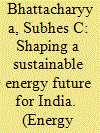

|
|
|
|
|
| Publication |
2010.
|
| Summary/Abstract |
Most of the studies on the Indian energy sector focus on the possible future scenarios of Indian energy system development without considering the management dimension to the problem-how to ensure a smooth transition to reach the desired future state. The purpose of this paper is to highlight some sector management concerns to a sustainable energy future in the country. The paper follows a deductive approach and reviews the present status and possible future energy outlooks from the existing literature. This is followed by a strategy outline to achieve long-term energy sustainability. Management challenges on the way to such a sustainable future are finally presented. The paper finds that the aspiration of becoming an economic powerhouse and the need to eradicate poverty will necessarily mean an increase in energy consumption unless a decoupling of energy and GDP growth is achieved. Consequently, the energy future of the country is eminently unsustainable. A strategy focussing on demand reduction, enhanced access, use of local resources and better management practices is proposed here. However, a sustainable path faces a number of challenges from the management and policy perspectives.
|
|
|
|
|
|
|
|
|
|
|
|
|
|
|
|
| 7 |
ID:
166365
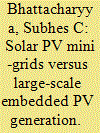

|
|
|
|
|
| Summary/Abstract |
Despite significant grid expansion during the last decade, globally India has the highest number of people lacking access to electricity. Mini-grid has been suggested as a possible electrification option and the new mini-grid policy of the state of Uttar Pradesh has attracted global attention. Relatedly, the drive for grid extension restricts off-grid areas to very remote locations and enhances the risks for mini-grid projects. Simultaneously, the pledge for increasing renewable energy share in the power supply mix opens the possibility of large-scale embedded renewable energy generation in the rural areas. This paper investigates the viability of solar PV-based mini-grids using a discounted cash flow analysis and considers the UP-policy prescriptions to explore the case of a megawatt (MW)-scale grid-connected solar PV under a power purchase agreement. It identifies the viability support requirements for both cases under different business conditions. It finds that mini-grids are not a viable proposition if the tariff prescribed in UP is used and that other cost minimising support (such as capital subsidy or low interest debt or an output-based subsidy) would be required to attract private investments. Large-scale solar projects, on the other hand, are more viable and can be an attractive proposition for rural electrification in the Indian context.
|
|
|
|
|
|
|
|
|
|
|
|
|
|
|
|
| 8 |
ID:
126527
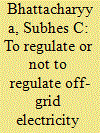

|
|
|
|
|
| Publication |
2013.
|
| Summary/Abstract |
As off-grid electrification receives global attention in the Sustainable Energy for All initiative, the role of regulation for this alternative form of electricity delivery requires a careful investigation. This paper asks whether the activity has to be regulated or not. It then tries to find out where regulation can be used and what type of regulation is appropriate. It suggests that for product-type delivery options, there is no justification for regulatory intervention in the sense of utility regulation but such intervention makes sense in the case of mini-grid-based off-grid delivery options. The paper considers the pros and cons of a generic license waiver, a simplified regulatory arrangement and a full-fledged regulatory supervision and suggests that a light-handed approach is appropriate in general to promote the activities of the sub-sector but more formal approaches may be required if the players do not abide by the rules. The paper also highlights some regulatory challenges and issues.
|
|
|
|
|
|
|
|
|
|
|
|
|
|
|
|
|
|
|
|
|